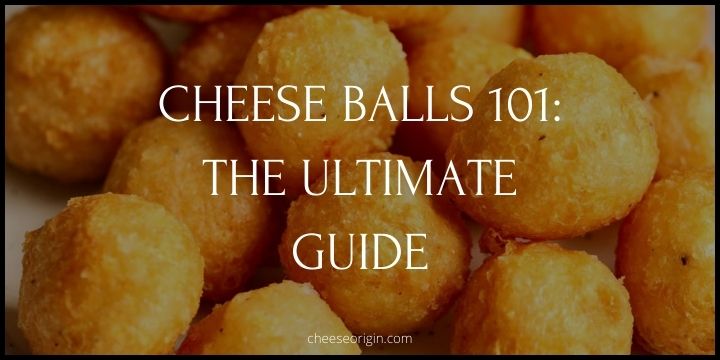What are Cheese Balls? The Perfect Party Food that’s Making a Comeback

In this post, we’re going to embark on a delicious journey exploring the art and science behind creating the perfect cheese ball.
From its fascinating history to the myriad of ways, it can be customized to cater to every palate, the humble cheese ball is much more than a party appetizer; it’s a canvas for creativity and a testament to the versatility of cheese.
So, whether you’re an experienced chef looking for innovative ideas or a novice cook wanting to impress your guests at the next gathering, this blog will equip you with everything you need to know about making mouth-watering cheese balls.
Let’s get rolling!
Also read: Utz Cheese Balls: The Ultimate Guide (Taste the Tradition)
Quick Facts About Cheese Balls
| Fact | Description |
|---|---|
| Origin | United States |
| Main Ingredients | Cheese (often cream cheese, cheddar), spices, and sometimes nuts or herbs |
| Texture | Soft and creamy inside, often with a crunchy coating |
| Flavor | Varies, but often tangy and savory |
| Color | Varies, often white or yellow depending on cheese used |
| Serving Suggestions | Often served as an appetizer with crackers, bread, or vegetables |
| Varieties | There are many variations, including different types of cheese, added ingredients like bacon or jalapenos, and different coatings like chopped nuts or herbs |
| Shelf Life | Can be refrigerated for up to two weeks if not served immediately |
What are Cheese Balls Made of?
Classic cheese balls are typically made of the following 5 ingredients:
- Cheese: This is the primary ingredient. Usually, a combination of cream cheese and another variety like cheddar or blue cheese is used.
- Spices: To enhance the flavor, spices such as garlic powder, onion powder, and paprika are often included.
- Herbs: Fresh or dried herbs like parsley, dill, and chives can be added for additional flavor.
- Nuts: The outer layer of the cheese ball is often coated with crushed nuts such as almonds, pecans, or walnuts for added crunch.
- Accompaniments: Cheese balls are often served with crackers, pretzels, or slices of baguette.
What Cheeses are Best for Cheese Balls?
Cheese balls are typically made with a base of cream cheese and often another type of cheese for added flavor.
Always Use Cream Cheese for Your Base
- Cream Cheese: This is your base. It’s smooth, creamy, and has a mild flavor that serves as an excellent canvas for other ingredients.
4 Suitable Cheeses for Added Flavors
- Sharp Cheddar: Adding cheddar to your cheese ball gives it a robust, sharp taste. It pairs well with most toppings and adds depth to the overall flavor.
- Blue Cheese: If you prefer strong, pungent flavors, blue cheese is a great addition. It’s not for everyone, but lovers of blue cheese will appreciate the distinct tang it brings to the table.
- Gouda: Smoked gouda can give your cheese ball a unique twist. The smoky flavor complements the cream cheese and adds a complexity that’s sure to impress your guests.
- Goat Cheese: For a tangy, earthy flavor, try adding goat cheese to your mix. It’s rich and creamy, much like cream cheese, but offers a completely different flavor profile.
What Goes Well with Cheese Balls? A Pairing Guide
Cheese balls, with their versatile flavors and textures, can be paired with a variety of accompaniments to enhance their taste.
Here are some food items that go well with cheese balls:
1. Fruit Slices:
Pear and apple slices can serve as a refreshing and slightly sweet contrast to the savory cheese. They add a crisp texture and natural sweetness that complements the creaminess of the cheese ball.
Also read: What Fruit Goes on a Charcuterie Board?
2. Crostini:
These small, toasted slices of bread provide a crunchy base that holds up well against the rich cheese. They’re also great for scooping up any extra bits of cheese or toppings.
3. Crudité:
For a healthier option, raw vegetables like carrots, cucumbers, or bell peppers can be used. Their crunch and fresh flavors balance out the cheese’s richness.
4. Toasted Mini Bagels and Pretzels:
Just like crostini, these provide a sturdy base for the cheese. Plus, their unique flavors add an extra layer of deliciousness.
5. Crackers:
Water crackers, graham crackers, and pita chips are popular choices. They’re sturdy enough to hold a generous amount of cheese and come in various flavors that can complement your cheese ball.
Also read: 11 Best Crackers that Pair Well with Cheese
6. Booze Pairings:
If you’re serving your cheese ball at an event where alcohol is appropriate, pairing it with certain types of booze can take the flavor to the next level. For instance, Old Overholt Rye or Rittenhouse Rye and Carpano Antica Vermouth are recommended to pair with smoky cheese balls.
Also read: Best Wine and Cheese Pairings: The Ultimate Guide
Why are Cheese Balls so Popular?
A Glimpse into the History
Cheese balls have seen a surge in popularity due to a variety of factors. Their origin can be traced back to the early 1800s when soft cheese was molded into a ball shape and adorned with different seeds, nuts, or dried fruit. This versatile snack offers endless possibilities, whether sweet or savory.
In the mid-20th century, cheese balls became a classic appetizer, particularly popular from the 50s through the 70s. They may have experienced a dip in reputation during the 80s and 90s, being seen as somewhat passé, but have since made a comeback in the 21st century.
What Makes Cheese Balls so Appealing and Popular?
One of the appealing aspects of cheese balls is their versatility. Tiny cheese balls, for instance, are appreciated because they allow for a variety of flavors, require less preparation time, and eliminate the need for sharing.
Beyond their taste, cheese balls are a hit at parties due to their ease of preparation and customization options. Different cheeses and toppings can be used to cater to various palates.
Despite some initial associations with processed cheese products like Velveeta, modern food lovers have come to respect the cheese ball for its potential for high-quality ingredients and creative presentations.
Popular in the World of Snacks
Cheese balls are also popular in the snack world. The tanginess of real cheddar cheese in products like Utz Cheese Balls gives them an unmistakable flavor that melts in your mouth.
Cultural Significance
The cultural significance of cheese balls also plays a role in their popularity. They are often associated with communal gatherings and festive occasions, symbolizing a sense of togetherness.
Given these factors, it’s no surprise that cheese balls have gained and retained their popularity over the years.
Our 4 Most-favorited Cheese Ball Recipes
Today, I am excited to share with you my top four most-favorited cheese ball recipes. From vegan options to sweet and savory delights, there’s something for everyone.
Sure, here’s your information in table format:
| Cheese Ball Recipe | Description | Key Ingredients | Pro Tips |
|---|---|---|---|
| The Classic Cheese Ball | This is where it all begins. The tanginess of the green onions and Worcestershire sauce balances the richness of the cheese, while the pecans add a delightful crunch. | Cream cheese, sharp cheddar cheese, green onions, Worcestershire sauce, chopped pecans. | Let the cheese ball sit for a couple of hours before serving, this allows the flavors to meld together. |
| Vegan “Cheese” Ball | This one is for our plant-based friends. Nutritional yeast gives a cheesy flavor without the dairy. A bit of smoked paprika adds a bit of kick. Chopped fresh parsley adds pop of color and freshness. | Soaked raw cashews, nutritional yeast, smoked paprika, fresh parsley. | None |
| Sweet and Savory Blue Cheese and Pear Cheese Ball | This is a unique twist on the traditional cheese ball. The sweetness of the pear compliments the strong, tangy flavor of the blue cheese, and the addition of honey adds a touch of decadence. The outside is coated in chopped walnuts for a nice crunch. | Blue cheese, pear, honey, walnuts. | None |
| Spicy Jalapeno Popper Cheese Ball | If you like a bit of heat, this one’s for you. The spicy jalapenos and smoky bacon make this cheese ball irresistibly delicious. | Cream cheese, shredded cheddar, diced jalapenos, crispy cooked bacon. | Remove the seeds from the jalapenos if you want less heat. |
My personal experience with these cheese balls has always been a hit at parties.
I’ve made slight modifications to the original recipes, like adding more heat to the Jalapeno Popper Cheese Ball and playing around with the types of nuts for coating.
In summary, these four cheese ball recipes stand out because of their variety in flavors and adaptability to different dietary preferences.
Whether you’re a fan of the classics, on a plant-based diet, love the combination of sweet and savory, or crave some heat, there’s a cheese ball for you.
Happy cheese ball making!
Frequently Asked Questions
1. Do cheese balls have MSG?
Not all cheese balls contain MSG. For instance, Utz Cheese Balls are reported to be MSG-free according to a product overview on Spoonacular.
However, it is essential to note that some snack products, especially those with cheese or ranch flavors, might contain ingredients like hydrolyzed soy protein or autolyzed yeast, which can serve similar functions to MSG. (source)
Therefore, while some brands ensure their cheese balls are MSG-free, it’s always important to check the ingredient list of any product if you’re trying to avoid MSG.
2. Is cheese ball good for health?
Cheese balls can have some nutritional benefits, but like many foods, they should be consumed in moderation.
According to various sources, cheese balls are a good source of protein, vitamins, minerals, and healthy fats.
Some healthier versions of cheese balls use Greek yogurt instead of sour cream or mayo, which can increase the protein content and lower the fat content.
However, it’s important to note that not all cheese balls are created equal. Some may contain high levels of unhealthy fats, such as trans fats, which can raise cholesterol levels and increase the risk of heart disease.
Also, specific recipes, like Cheese Corn Balls, might not be suitable for individuals with diabetes, heart conditions, or those trying to lose weight.
Therefore, while cheese balls can offer some nutritional value, it’s essential to consider the ingredients and your dietary needs.
3. Are cheese puffs and cheese balls the same thing?
Cheese puffs and cheese balls are often used interchangeably, but they do have some distinct differences.
| Cheese Balls | Cheese Puffs | |
|---|---|---|
| Shape | Spherical | Irregular, often elongated |
| Texture | Maintain a delightful crunch throughout | Known for their airy and light feel |
| Main Ingredient | Made from puffed corn | Made from puffed corn |
| Flavor | Cheesy | Cheesy |
| Noted Brands | UTZ Cheese Balls | Cheetos Puffs |
4. Why is my cheese ball too soft?
If your cheese ball is too soft, it could be due to several factors:
- Type of Cheese: If you’re using soft cheeses like cream cheese or goat cheese, your cheese ball might not hold its shape well.
- Moisture Content: Too much moisture in the cheese can make the cheese ball too soft.
- Insufficient Chilling: If the cheese isn’t chilled long enough before forming the ball, it may not firm up properly.
- Ratio of Ingredients: If there’s too much of other mix-ins like sour cream, mayo, or yogurt, it could result in a softer cheese ball.
Solution
Try using harder cheeses, reducing the moisture, chilling the cheese adequately, or adjusting the ratio of cheese to other ingredients.
5. How long will cheese ball last in fridge?
The typical lifespan of cheese ball can typically last around two weeks in the fridge.
However, it may vary due to these factors:
- Fresh Ingredients: If fresh herbs or diced fruit are included, the cheese ball’s shelf life may reduce to 24-48 hours.
- Homemade Cheese Balls: These usually last for up to four days in the fridge. If made with processed cheese, they could last longer. Usually around a week to two.
- Proper Storage: A well-stored cheese ball can potentially last up to four weeks in the refrigerator.
- Check for Spoilage: Always check the expiration date on the package and be aware of changes in texture or smell as these could indicate spoilage.
Conclusion
In conclusion, the world of cheese balls is as diverse and exciting as it is delicious.
From understanding why your cheese ball might be too soft, to knowing how long it can last in the fridge, our journey through the flavors and textures of cheese balls has been a culinary adventure.
Whether you’re a fan of creamy textures or a connoisseur of robust flavors, there’s a cheese ball recipe out there for you.
Remember, the key to a perfect cheese ball lies in the quality of ingredients, the balance of flavors, and proper storage.
So the next time you’re planning a gathering or simply craving a savory treat, don’t shy away from crafting your own cheese masterpiece.
Happy cheese ball making!
Also read:
- Is Processed Cheese Good or Bad? Let’s Find Out!
- Savor the Flavor: 20 Cheeses with the Least Lactose
- Best Wine and Cheese Pairings: The Ultimate Guide
- The Science of Cheesemaking: A Journey from Milk to Artisanal Delight
- What Kind of Cheese is Used on Nachos?
- Cheese Nips: A Bite-sized Exploration of Flavor and History
- What is Cheese Tea? A Quirky Twist on a Classic Beverage
- What Pairs Well with Cheddar: The Ultimate Guide
- 12 Most Popular Cheeses in the World
- What is Cheez Whiz? Understanding Its Origins and Popularity





